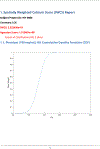Semi-Automatic Graphical Tool for Measuring Coronary Artery Spatially Weighted Calcium Score from Gated Cardiac Computed Tomography Images
- PMID: 37811943
- PMCID: PMC10897968
- DOI: 10.3791/65458
Semi-Automatic Graphical Tool for Measuring Coronary Artery Spatially Weighted Calcium Score from Gated Cardiac Computed Tomography Images
Abstract
The current standard for measuring coronary artery calcification to determine the extent of atherosclerosis is by calculating the Agatston score from computed tomography (CT). However, the Agatston score disregards pixel values less than 130 Hounsfield Units (HU) and calcium regions less than 1 mm2. Due to this thresholding, the score is not sensitive to small, weakly attenuating regions of calcium deposition and may not detect nascent micro-calcification. A recently proposed metric called the spatially weighted calcium score (SWCS) also utilizes CT but does not include a threshold for HU and does not require elevated signals in contiguous pixels. Thus, the SWCS is sensitive to weakly attenuating, smaller calcium deposits and may improve the measurement of coronary heart disease risk. Currently, the SWCS is underutilized owing to the added computational complexity. To promote translation of the SWCS into clinical research and reliable, repeatable computation of the score, the aim of this study was to develop a semi-automatic graphical tool that calculates both the SWCS and the Agatston score. The program requires gated cardiac CT scans with a calcium hydroxyapatite phantom in the field of view. The phantom allows for deriving a weighting function, from which each pixel's weight is adjusted, allowing for the mitigation of signal variations and variability between scans. With all three anatomical views visible simultaneously, the user traces the course of the four main coronary arteries by placing points or regions of interest. Features such as scroll-to-zoom, double-click to delete, and brightness/contrast adjustment, along with written guidance at every step, make the program user-friendly and easy to use. Once tracing the arteries is complete, the program generates reports, which include the scores and snapshots of any visible calcium. The SWCS may reveal the presence of subclinical disease, which may be used for early intervention and lifestyle changes.
Conflict of interest statement
DISCLOSURES:
The authors declare that they have no conflicts of interest to disclose.
Figures








References
-
- O’Malley PG, Taylor AJ, Jackson JL, Doherty TM, Detrano RC Prognostic value of coronary electron-bean computed tomography for coronary heart disease events in asymptomatic populations. The American Journal of Cardiology. 85 (8), 945–948 (2000). - PubMed
-
- Budoff MJ et al. Assessment of coronary artery disease by cardiac computed tomography. Circulation. 114 (16), 1761–1791 (2006). - PubMed
-
- Rumberger JA, Simons DB, Fitzpatrick LA, Sheedy PF, Schwartz RS Coronary artery calcium area by electron-beam computed tomography and coronary atherosclerotic plaque area. Circulation. 92 (8), 2157–2162 (1995). - PubMed
-
- Mautner GC et al. Coronary artery calcification: assessment with electron beam CT and histomorphometric correlation. Radiology. 192 (3), 619–623 (1994). - PubMed
-
- Agatston AS et al. Quantification of coronary artery calcium using ultrafast computed tomography. Journal of the American College of Cardiology. 15 (4), 827–832 (1990). - PubMed
Publication types
MeSH terms
Substances
Grants and funding
LinkOut - more resources
Full Text Sources
Medical
